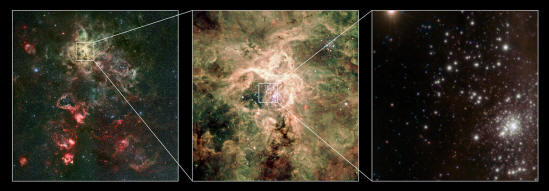(Electric Universe) '..there are no maximum or minimum sizes for stars.' - Mel Acheson
Posted by ProjectC
<blockquote>'Plasma astronomy posits a relationship between electrical stress and luminosity. Gravity, and consequently mass, is a weak manifestation of electrical stress. In regions that are relatively insulated from the primary effects of electricity (within stellar sheaths, such as the Sun’s heliosphere), gravity will largely determine orbital motions.
However, the mass that is calculated from analysis of the orbits is a result of the charge contained, not of the quantity of matter as is commonly assumed. In an Electric Universe, there are no maximum or minimum sizes for stars.'</blockquote>
<center>
The Tarantula Nebula (left and center). Star cluster R136 (right).
Credit: ESO/P. Crowther/C.J. Evans.</center>
Galactic Thunderbolts
By Mel Acheson
Jan 10, 2011
Source
Consensus astronomers look at individual points of light and discover the most massive stars. Electric Universe observers look at the entire complex of filaments and discover the characteristic features of a galactic thunderbolt.
“Mass” astronomy posits a relationship between mass and luminosity. By observing a double star system in the cluster shown at the top of the page, astronomers were able to calculate a baseline for the relationship and extrapolate the masses of brighter stars. They found some that were nearly twice as massive as they had thought possible. Although, since theories are often adjusted to explain any observation, failures of expectations cannot be equated with falsifications of theory.
Plasma astronomy posits a relationship between electrical stress and luminosity. Gravity, and consequently mass, is a weak manifestation of electrical stress. In regions that are relatively insulated from the primary effects of electricity (within stellar sheaths, such as the Sun’s heliosphere), gravity will largely determine orbital motions.
However, the mass that is calculated from analysis of the orbits is a result of the charge contained, not of the quantity of matter as is commonly assumed. In an Electric Universe, there are no maximum or minimum sizes for stars.
The objects of interest to plasma astronomers are the helical filaments that give the regions around the clusters their characteristic electrical structure. In the far view (left), arcs of parallel filaments appear to wind around kinked tubes that converge on the cluster, evidence for large plasma discharge channels.
Where channels intersect (center view), the stress increases. Bubbles form (exploding double layers, similar to coronal mass ejections), secondary discharges are induced, and instabilities pinch plasma into stars. The observed large outflow of material, mischaracterized as mass (and misnamed “wind”), is the electrical current flow coursing through the region like a galactic lightning bolt.
Instead of a random scattering of gravitationally collapsing clouds shaped by hot winds, these regions are unitary plasma discharge formations better called galactic thunderbolts.
Mel Acheson
*** Context
<blockquote>- 'The real world is constantly changing, while mathematical models..'
- '..the sun’s intermediate position on a cosmic power cable no longer sound outrageous..'</blockquote>
However, the mass that is calculated from analysis of the orbits is a result of the charge contained, not of the quantity of matter as is commonly assumed. In an Electric Universe, there are no maximum or minimum sizes for stars.'</blockquote>
<center>

The Tarantula Nebula (left and center). Star cluster R136 (right).
Credit: ESO/P. Crowther/C.J. Evans.</center>
Galactic Thunderbolts
By Mel Acheson
Jan 10, 2011
Source
Consensus astronomers look at individual points of light and discover the most massive stars. Electric Universe observers look at the entire complex of filaments and discover the characteristic features of a galactic thunderbolt.
“Mass” astronomy posits a relationship between mass and luminosity. By observing a double star system in the cluster shown at the top of the page, astronomers were able to calculate a baseline for the relationship and extrapolate the masses of brighter stars. They found some that were nearly twice as massive as they had thought possible. Although, since theories are often adjusted to explain any observation, failures of expectations cannot be equated with falsifications of theory.
Plasma astronomy posits a relationship between electrical stress and luminosity. Gravity, and consequently mass, is a weak manifestation of electrical stress. In regions that are relatively insulated from the primary effects of electricity (within stellar sheaths, such as the Sun’s heliosphere), gravity will largely determine orbital motions.
However, the mass that is calculated from analysis of the orbits is a result of the charge contained, not of the quantity of matter as is commonly assumed. In an Electric Universe, there are no maximum or minimum sizes for stars.
The objects of interest to plasma astronomers are the helical filaments that give the regions around the clusters their characteristic electrical structure. In the far view (left), arcs of parallel filaments appear to wind around kinked tubes that converge on the cluster, evidence for large plasma discharge channels.
Where channels intersect (center view), the stress increases. Bubbles form (exploding double layers, similar to coronal mass ejections), secondary discharges are induced, and instabilities pinch plasma into stars. The observed large outflow of material, mischaracterized as mass (and misnamed “wind”), is the electrical current flow coursing through the region like a galactic lightning bolt.
Instead of a random scattering of gravitationally collapsing clouds shaped by hot winds, these regions are unitary plasma discharge formations better called galactic thunderbolts.
Mel Acheson
*** Context
<blockquote>- 'The real world is constantly changing, while mathematical models..'
- '..the sun’s intermediate position on a cosmic power cable no longer sound outrageous..'</blockquote>